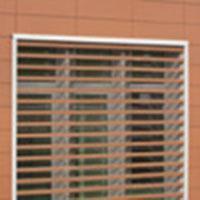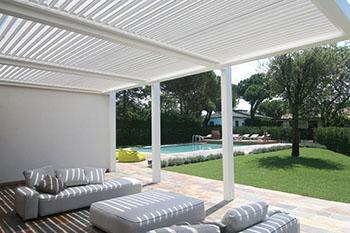Brise soleil
Post from EditorialsTo shield from the solar radiation you can use the brise soleil or solar shading, constituted by a series of parallel slats, fixed or adjustable.
Importance of shielding from solar radiation

To ensure proper hygrothermal well-being to the occupants of a building during the summer, especially during the middle (and therefore warmer) in the foreheads of the day and more exposed to solar radiation (ie, those exposed to the south and west), it is essential to provide the installation of appropriate shading systems and shielding, consisting, for example jetties and sheds, pergolas with vegetation cover, sheeting fabric (curtains or shade sails) and of course from brise soleil and solar shading.
Operation of the brise soleil

Among these shielding systems, the most effective is definitely formed by the brise soleil, consisting of a series of plates, strips or blades of various materials (usually wood or aluminum) parallely arranged between them and whose operation plans to mitigate the rays of the sun, with an effect quite similar to that of the trees.
Based on the various types of brise soleil, the slats may be mobile or fixed, that is oriented according to a predetermined angle, generally studied so to screen the sunlight in the summer period, when it is closer to the zenith, and instead to allow the sunshine during the winter, with the sun low on the horizon.
Brise soleil fixed
The brise solei fixed are generally placed above or in front of each window (or even to each row of windows), on the cover with a projection sufficient to screen solar radiation on the lower floors, or finally on the whole facade, so it also become an architectural feature of the facade or of the entire building.
The series of slats can be mounted both horizontally and vertically, as is the case for example for products by the company Alufiero, constituted by systems of sunblinds modular and prefabricated, with aluminum slats fixed or adjustable thanks to an electrical or manual control. This product is therefore very versatile and suitable for both existing buildings (residential, commercial or tertiary-executive functions) that new construction: in this second case, the brise soleil will be able to be provided from the planning stage and therefore fit perfectly from the aesthetic and functional point of view. For those who prefer other materials, the Eclipse line by the company Vettaflex offers a wide range of shading devices with strips of pvc, larch wood, or even cotto tile, especially suitable for buildings on the mountain or renovation of existing buildings, such as old barns or farmhouses: the brise soleil floors are inspired by the typical mandolato in fact, widespread, for example in the granaries and barns of the Po valley and consists of modular elements combined in various combinations to form tunnels and decorative trellises, also useful for lighting, ventilation and shielding of sunlight within the various environments.
For those who prefer other materials, the Eclipse line by the company Vettaflex offers a wide range of shading devices with strips of pvc, larch wood, or even cotto tile, especially suitable for buildings on the mountain or renovation of existing buildings, such as old barns or farmhouses: the brise soleil floors are inspired by the typical mandolato in fact, widespread, for example in the granaries and barns of the Po valley and consists of modular elements combined in various combinations to form tunnels and decorative trellises, also useful for lighting, ventilation and shielding of sunlight within the various environments.
Although the brise soleil fixed offer a less efficient solar shielding, if arranged in front of windows to have some additional advantages, such as help to shield the building from the noise (due to the reflection power of each plate) and make more difficult the intrusions and unlawful acts of vandalism.
Brise soleil adjustable
 The best protection from the sun and sun screening, however, is only obtainable with brise soleil adjustable, able to ensure an optimal adjustment of shading is based on the time of year, and on the different times of the day.
The best protection from the sun and sun screening, however, is only obtainable with brise soleil adjustable, able to ensure an optimal adjustment of shading is based on the time of year, and on the different times of the day.
In this case, each plate is fixed on a rotatable pin, and all the elements of the series are made integral with each other and remotely operated with a manual or electric.
The optimal use of this system is undoubtedly the construction of roofs (also perfectly horizontal) similar to huts or shelters, for example, placed to protect the entrance of a building or ancillary spaces such as terraces and flat roofs: it is a excellent example the product Blade 160 of the firm Studio 66, with completely smooth surfaces in the upper and lower level: this feature is very important because it prevents the accumulation of debris carried by the wind (leaves, twigs, paper, etc.) between the slats, difficult to remove after the installation of brise soleil.
Furthermore, the dimensions of the slats and of the tubular support are always determined in relation to the existing building and they are completely free of screws or other similar elements on view, giving to the whole a remarkable aesthetic value. The rotation of the blades varies from 0 to 135 degrees, allowing natural ventilation even in the hottest days.
79586 REGISTERED USERS










